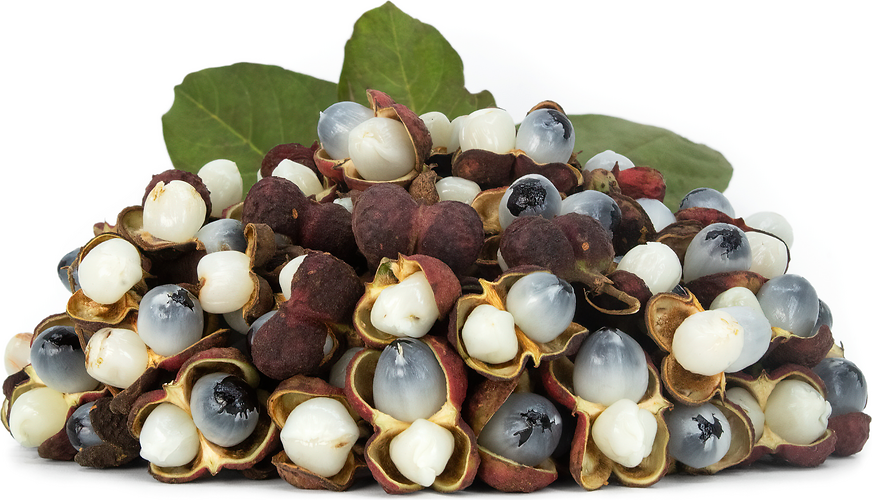


Matayba Fruit
Estimated Inventory, lb : 0
Description/Taste
Matayba fruits are small in size and are comprised of 2 to 3 deeply lobed capsules growing at the end of branches in small clusters. Each capsule averages 1 to 2 centimeters in length and 1 to 1.5 centimeters in diameter, and as it matures, it splits open to reveal seeds enveloped in fleshy arils. The capsule’s exterior matures from green to variegated shades of red, dark purple, to red-purple hues and has a dry, leathery, and fibrous feel. After the capsule breaks open, the fleshy white to translucent arils contain 2 to 3 hard black seeds. Each seed ranges from 6 to 10 millimeters in length and has a glossy appearance. It is not generally recommended to consume Matayba fruits. Some communities in South America eat the arils of the fruit raw, but more research needs to be conducted to determine the safety of ingesting the fruit.
Seasons/Availability
Matayba flowers and fruits in the spring in South America and during the wet season in Central America, typically from September through November.
Current Facts
Matayba, botanically a part of the Matayba genus, is a broad category of many tropical fruiting species belonging to the Sapindaceae family. The small fruits develop on shrubs to small trees reaching 6 to 24 meters in height, depending on their growing environment, and are a wild plant that has been naturally growing for centuries. There are over fifty species within the Matayba genus, and each species is found in varying regions spanning from Mexico south to Brazil. Matayba is not commercially cultivated, and the species is considered rare. In Central and South America, Matayba is known by many regional names, including Guacharaco, Camboatá, Camboatã, Camboatá−branco, Olho−de−cotia, Mataíba, Brazeiro, Cuvantã, Jatuá-uba, and Batabaíba. Matayba has remained primarily a foraged species, and several portions of the plant are hand-collected among indigenous communities in Central and South America for medicinal purposes.
Nutritional Value
Portions of the Matayba tree are incorporated into traditional medicines among indigenous communities in Mexico, Central, and South America. Each Matayba species will vary in its nutritional properties, but in general, the bark of the tree is used in decoctions and infusions as a natural mouthwash and remedy for toothaches. The bark is also scraped until it turns white and is mixed with other ingredients to soothe wounds and topical cuts or used in other remedies for diarrhea. The roots are used in infusions to lessen back pain and the fruit’s exterior is filled with saponins, used to make a foaming wash. Beyond specific uses, Matayba species are viewed as having properties to act as a natural relaxant, inflammation reducer, and natural antiseptic.
Applications
Matayba fruits are heavily debated among experts on whether they are edible. The general consensus is more research needs to be conducted before conclusions can be made and it is recommended to not eat the fruit to ensure overall health and safety. Historically, some communities throughout Central and South America have eaten the fruit in small quantities and have not experienced side effects. Other scientific sources have mentioned that the fruits are considered poisonous and can cause a mental imbalance. There are many species within the Matayba genus with fruits, and as additional research is conducted over time on the varying species, clarification can be given for these fruits.
Ethnic/Cultural Info
Matayba is a treasured wild species in Colombia and is appreciated beyond its medicinal uses. The trees are found in the Magdalena Valley, parts of the Andes, the Amazon, the Pacific, and in Orinoquia within Colombia, and multiple portions of the tree are used for environmental and cultural purposes. The wood from the tree is easy to cut but has a heavy feel, making it suitable for use as boards in construction or for making boxes. The wood is also used to make spinning tops and various childhood games. In addition to construction, Matayba trees produce many clusters of flowers, which attract pollinators. These blooms later turn into fruit and the fruits are consumed by birds as a natural food source. When birds consume the fruits, the seeds are scattered throughout forests, helping the species spread. Matayba trees are believed to help restore forests in Colombia, and the natural expansion of the species is welcomed. The trees are viewed as beneficial plants for soils, and though the species is not commercially cultivated, it is respected among communities for its life-giving properties.
Geography/History
Species within the Matayba genus are native to tropical regions of Mexico, Central, and South America and have been growing wild since ancient times. In open savannahs, the species mostly remains a small shrub, but in forests, rainforests, and woodlands, they can grow into much larger trees. Matayba thrives in low-lying areas between 100 to 1000 meters above sea level and has remained primarily wild, naturally spreading through animals scattering the seeds. The species is also occasionally planted in home gardens as an ornamental. Today, Matayba trees are still localized to areas of South and Central America and are also found in Mexico and parts of the Caribbean. Portions of the tree may be sold in local markets for medicinal use and are a rare, seasonal find. The Matayba fruit featured in the photograph above was sourced through trees in Colombia.




